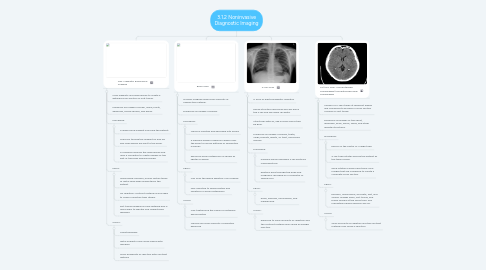
1. MRI: Magnetic Resonance Imaging
1.1. Uses magnets and radio waves to create a detailed cross section of soft tissue.
1.2. Produces 2D images of brain, spine, joints, abdomen, blood vessels, and pelvis.
1.3. Procedure:
1.3.1. A large round magnet surround the patient.
1.3.2. Scans by turning the magnet on and off and radio waves are sent to the body.
1.3.3. A machine receives the radio waves and uses a computer to create images of the part of the body being scanned.
1.4. PROS:
1.4.1. noninvasive; painless, unless certain types of metal have been implanted in the patient.
1.4.2. No radiation; contrast material is less likely to cause a reaction than others.
1.4.3. soft tissue imaging is more detailed and is more likely to identify and characterize diseases.
1.5. CONS:
1.5.1. Claustrophobia
1.5.2. metal implants may cause issues with machine
1.5.3. Small possibility of reaction with contrast material
2. Bone Scan
2.1. Nuclear imaging using small amounts of radioactive material.
2.2. produces 2D images of bones.
2.3. Procedure:
2.3.1. Tracer is injected and absorbed into bones
2.3.2. a machine passes a gamma camera over the body to record patterns of absorption in bones
2.3.3. abnormal bone metabolism is shown as lighter or darker
2.4. PROS:
2.4.1. Can scan the whole skeleton; non invasive
2.4.2. very sensitive to abnormalities and variations in bone metabolism
2.5. CONS:
2.5.1. Can't determine the cause of metabolic abnormalities
2.5.2. Tracers use small amounts of radiation exposure
3. X-ray Scan
3.1. A form of electromagnetic radiation
3.2. Dense structure like bones will will block the x-ray and will show up white.
3.3. Structures with air, like muscle and fat will be gray.
3.4. Produces 2D images of bones, teeth, lungs, breasts, hearts, GI tract, and blood vessels.
3.5. Procedure:
3.5.1. machine sends individual x-ray particles called photons.
3.5.2. photons pass through the body and imaging is recorded on a computer or special film.
3.6. PROS:
3.6.1. quick, painless, noninvasive, and inexpensive.
3.7. CONS:
3.7.1. exposure to small amounts of radiation and the contrast material may cause an allergic reaction.
4. CT/CAT scan: Computerized Tomography/Computerized Axial Tomography
4.1. a series of X-rays taken at different angles and combined to produce a cross section of bone or soft tissue.
4.2. produces 2D images of the chest, abdomen, brain, pelvis, spine, and other skeletal structures.
4.3. Procedure:
4.3.1. person in the center of a large tube.
4.3.2. X-ray tube rotates around the patient as the table moves.
4.3.3. each rotation yields many thinly slice images that are combined to create a complete cross section.
4.4. PROS:
4.4.1. painless, noninvasive, accurate, fast, and simple. images bone, soft tissue, and blood vessels at the same time. Any implanted medical devices are OK.
4.5. CONS:
4.5.1. small amounts of radiation and the contrast material may cause a reaction.
